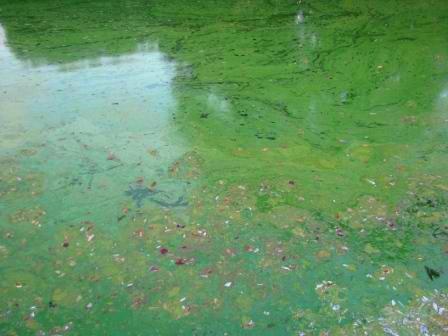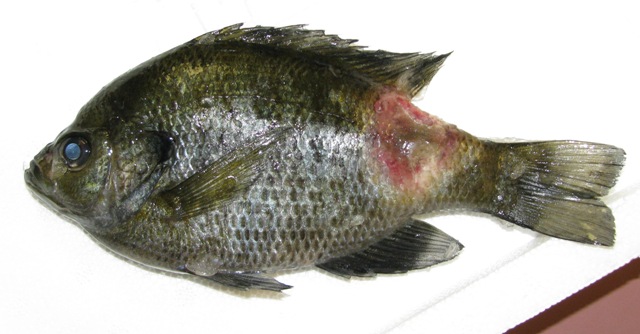Fish in ponds can die from several causes. Learn more about what may be causing your fish health problems.

-
Large fish are dying but not many small fish, or fish of all sizes and species are dying
Large fish are more susceptible to low oxygen conditions and turnovers than small fish. When a turnover or low oxygen event occurs, the large fish come to the surface and begin to die before the small fish. As the low oxygen event worsens, the small fish come to the surface and may be seen gasping and ventilating in the thin layer of water on the surface. Low oxygen events most frequently occur just before sunrise, because oxygen levels are at their lowest at this time of day. Photosynthesis is not occurring because there is no sunlight, meanwhile plankton and microbes in the water are still respiring and consuming oxygen. As a result, oxygen levels decline through the night, and the first signs of a low oxygen event are usually seen in the early morning. By afternoon, photosynthesis may have put enough oxygen in the water to satisfy the needs of the fish. Low oxygen is the most likely reason for fish kills in stormwater ponds. Oxygen related fish kills are most common in the fall when storms and windy days cause rapid "turn-overs," but they also can occur anytime during the growing season if an intense algal bloom occurs.
How do I stop fish from dying from a low oxygen event?
Circulate the water. Circulating the water prevents the pond from stratifying (establishing a thermocline) and forming a layer of low oxygen water on the bottom. For guidance, see section on Aeration & Circulation. It must be emphasized that stormwater ponds are not designed to be ideal fish habitat. They are designed to manage stormwater, and the fact that they can harbor fish is a secondary benefit. Considering that stormwater ponds experience prolonged periods of still water interrupted by short periods of rapid mixing when it rains, they are more prone to turnovers and low oxygen fish kills than larger lakes and private fish ponds. -
Only small fish are dying but no large fish
Small fish are more susceptible to toxins than big fish. Assuming that the pond has both small juvenile fish and large mature fish, a fish kill that only affects the juveniles while larger adult fish appear to be unaffected often indicates that some form of toxin is in the water. Toxins may result from improper application of a pesticide, the release of an illicit discharge (such as a solvent or automotive fluid) into the storm drain system, or a blue-green (cyanobacteria) or red algae bloom. Cyanobacteria blooms are usually apparent because the water becomes cloudy and green like pea soup or develops a bright green or red surface film. (See section on Planktonic Algae) The image on the right shows an intense cyanobacteria bloom with numerous small fish the have been killed by the microcystin toxin that was released by the algae.
How do I deal with toxins in my pond?
Despite the source, it is nearly impossible to remove a toxin from the water once it has been introduced. The trick to managing toxin related fish kills is to prevent the toxin from being introduced into the system mainly by informing residents about proper fertilizer and pesticide use and proper disposal of household chemicals and automotive fluids. Stormwater ponds are largely dependent on the quality of the runoff that is flowing from roads and lawns in the neighborhood. Communities should be vigilant about illicit discharges into storm drains and ponds and report egregious offenses to the local stormwater or public works department. Assuming that the mature fish did not die, the fish population should rebound after the toxin has left the system. In some cases the pond may need to be restocked. -
I see fish of only one species dying, or fish look diseased or with parasites
Differential death of only one species of fish may be the result of an environmental condition such as low oxygen or a disease or parasite. Some fish species are more susceptible to low oxygen than others. In mild low oxygen events, a few individuals from a single species may die without any other fish demonstrating symptoms, but the event is usually abrupt and short-lived and the dead individuals are the largest of that species. When disease or parasites are the cause, death usually occurs sporadically over a long period of time and affects all age groups of the species. A few fish die one day, a few more days later, and, over the course of a month or two, many death events may occur. Unlike low oxygen kills, death by disease or parasite usually is accompanied by other symptoms such as bulging eyes, discoloration of the skin or gills, evidence of small wounds or necrosis, external parasites clinging to the skin or gills, and so on. Fish diseases and parasites are not normally a significant cause of death in stormwater ponds, partially because fish rarely reach dense populations in these systems and the water is being exchanged regularly with each passing storm. If you are suspicious that fish in your pond are suffering from a disease or parasite, contact your Extension office or local fisheries office with the SC Department of Natural Resources for guidance.
SC DNR Fisheries Section Offices
- Charleston (843) 953-5291
- Clemson (864) 654-1671
- Columbia (803) 734-3886
- Florence (843) 661-4766
-
I see fish with wounds and scars
Fish often fall prey to predators and even may cannibalize their own kind. Some fish are fortunate enough to escape attack but remain scarred from the encounter. The most common predators that scar fish in stormwater ponds are ospreys, seagulls, herons, egrets, cormorants and anhingas, alligators, turtles and otters. These animals sometimes remove scales, cause scratches and puncture wounds, and trim or shred fins as they attempt to catch fish. Fish also may develop wounds from bedding activity. This is most evident as redness or scars on the lips and bottom of the tail fin.
Springtime Bream Death
 In the springtime, a peculiar type of death occurs most often with large bream, although it can happen with other species too. In March or early April, residents around ponds may report seeing a few large bream with large, gaping wounds on their sides, but they rarely see more than 10 fish per acre with these symptoms. This type of kill is most likely the result of winter stress and cannibalism. Over the winter, food resources are limited and the fish become stressed and malnourished. This affects the largest bream the most. As temperatures begin to warm in the spring, the fish become more active and sometimes attack each other. The pecking combined with malnourishment makes the fish vulnerable to infection and necrosis, which ultimately overcomes them. This type of bream death is more common in ponds that are overcrowded. If you get reports that small numbers of large bream are dying with large wounds in early spring, it is likely due to cannibalism. This will pass as the spring progresses and will not have a significant effect on the fish population.
In the springtime, a peculiar type of death occurs most often with large bream, although it can happen with other species too. In March or early April, residents around ponds may report seeing a few large bream with large, gaping wounds on their sides, but they rarely see more than 10 fish per acre with these symptoms. This type of kill is most likely the result of winter stress and cannibalism. Over the winter, food resources are limited and the fish become stressed and malnourished. This affects the largest bream the most. As temperatures begin to warm in the spring, the fish become more active and sometimes attack each other. The pecking combined with malnourishment makes the fish vulnerable to infection and necrosis, which ultimately overcomes them. This type of bream death is more common in ponds that are overcrowded. If you get reports that small numbers of large bream are dying with large wounds in early spring, it is likely due to cannibalism. This will pass as the spring progresses and will not have a significant effect on the fish population. -
I see mangled fish or skeletons on the bank
Mangled fish and bones on the bank is almost always an indication of an otter. Most other predators either ingest the entire fish (alligators, herons) or take the fish away from the pond to feed (osprey). Otters tend to enter and exit ponds in the same place forming a worn-down slide, and they tend to feed on their catch in the same places on the bank. Otters are somewhat messy eaters and leave behind scraps and bones after they have fed. They also have distinctive feces. Otters do not pose a significant threat to fish populations, except where ponds have been stocked with triploid grass carp. Otters may preferentially remove triploid grass carp from stormwater ponds. Otters are a protected fur-bearing species, so check state regulations before trapping them or speaking with a nuisance wildlife control operator. (See section on Beavers, Muskrats, and Otters)

